In the rapidly advancing world of AI voice generation, creators in 2025 are no longer just looking for realistic voices—they’re searching for platforms that help them scale, localize, and express content across multiple languages and formats.
Two of the most talked-about tools in this space are DupDub and ElevenLabs. While ElevenLabs has gained a reputation for its hyper-realistic English voices and massive community-generated library, DupDub has emerged as a full creative suite, combining voice generation with video dubbing, avatars, subtitle syncing, and multilingual output.
This article puts them head-to-head—comparing their voice quality, language support, voice cloning, pricing, and user workflows—to help you decide which tool truly delivers more in 2025.
Let’s start with a quick side-by-side overview of DupDub vs ElevenLabs
| Aspect | DupDub | ElevenLabs |
| Voice Quality | Very natural, expressive voices | Ultra-realistic voices |
| Language Support | 47 languages | 32 languages |
| Voice Library | 700+ voices with 1000+ styles | 5000+ voices (mostly user-generated/community-based) |
| Voice Cloning | Yes | Yes |
| Video Features | AI talking avatars, lip-sync dubbing | Audio dubbing only |
| Usability | All-in-one dashboard, moderate learning curve | Simple web interface, quick to use |
| Integrations & API | Yes | Yes |
| Free Tier | Free trial – 3-day Pro trial with 10 credits | Free plan – Ongoing free tier (10 min of voice generation) |
| Paid Plans & Pricing | Personal: $11/mo for 2 hours of voiceover. Professional: $30/mo for ~7 hours. Ultimate: $110/mo for ~34 hours. |
Starter: $5/mo for 0.5 hours of voiceover. Creator: $22/mo for ~1.7 hours. Pro: $99/mo for ~8.3 hours. Scale: $330/mo for ~33.3 hours. Business:$1320/mo for ~183.3 hours. |
| Best For | Multilingual content & video creators | Ultra-realistic English voiceovers |
Voice Quality and Realism
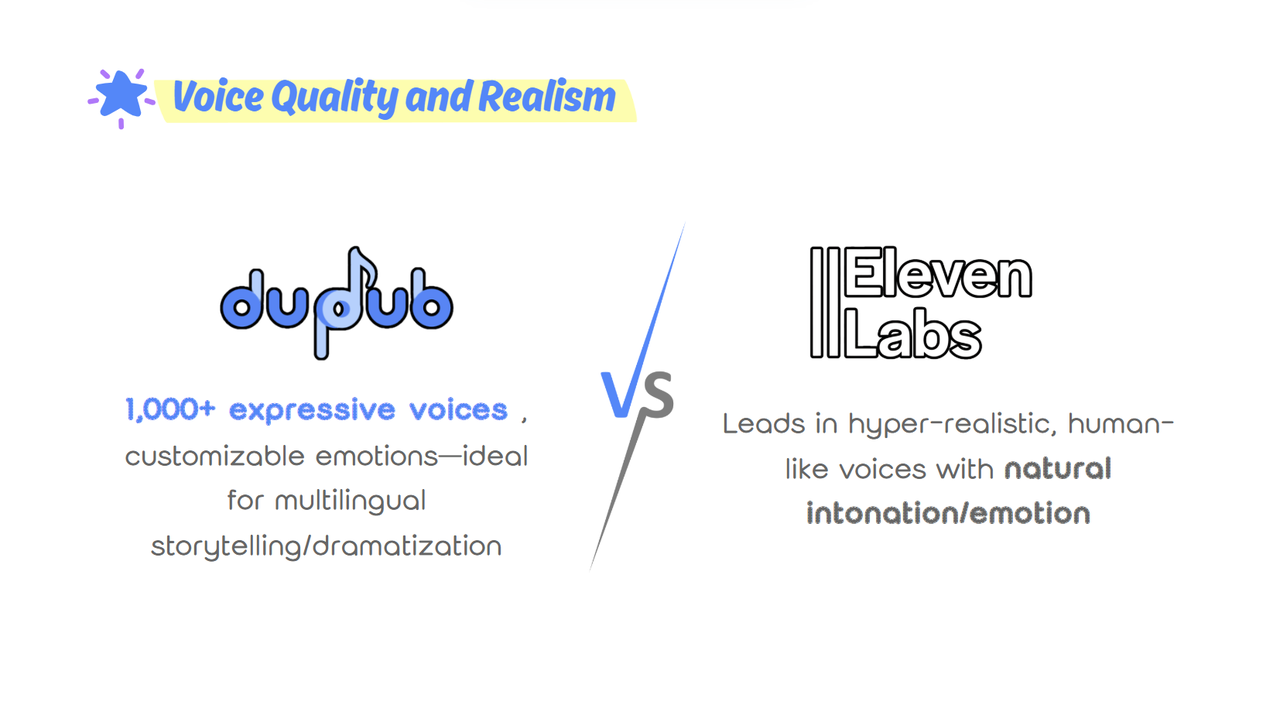
When it comes to voice naturalness, ElevenLabs has set a high bar. Its voices sound extremely human-like, capturing subtle inflections and emotions. The platform’s deep learning model produces speech with smooth intonation and pacing that can be almost indistinguishable from a real person. In English, especially ElevenLabs voices convey tone and emotion with impressive nuance. For example, a suspenseful narration or a cheerful dialogue can be rendered with convincing feeling. Many creators praise ElevenLabs for its hyper-realistic sound and expressive range in supported languages.
DupDub, on the other hand, also delivers very high-quality audio that feels natural to the ear. It offers over 1,000 voice styles, including various emotions and character tones. DupDub puts a big emphasis on expressiveness – it markets “Emotional AI Dubbing” that can portray laughter, sorrow, excitement, and more. In practice, DupDub’s voices are clear and life-like, and you can select voices or styles to inject specific emotions (e.g., a sad tone for a lament, an excited tone for a promo). This gives DupDub an edge for storytelling or roles that need dramatization.
Bottom line: Both platforms produce outstanding, natural-sounding speech. ElevenLabs focuses on achieving studio-quality realism (especially for English content), whereas DupDub focuses on natural sound with customizable expressiveness. If you want a variety of expressive voices for different moods (and different languages), DupDub shines brightly.
Language Support and Voice Variety
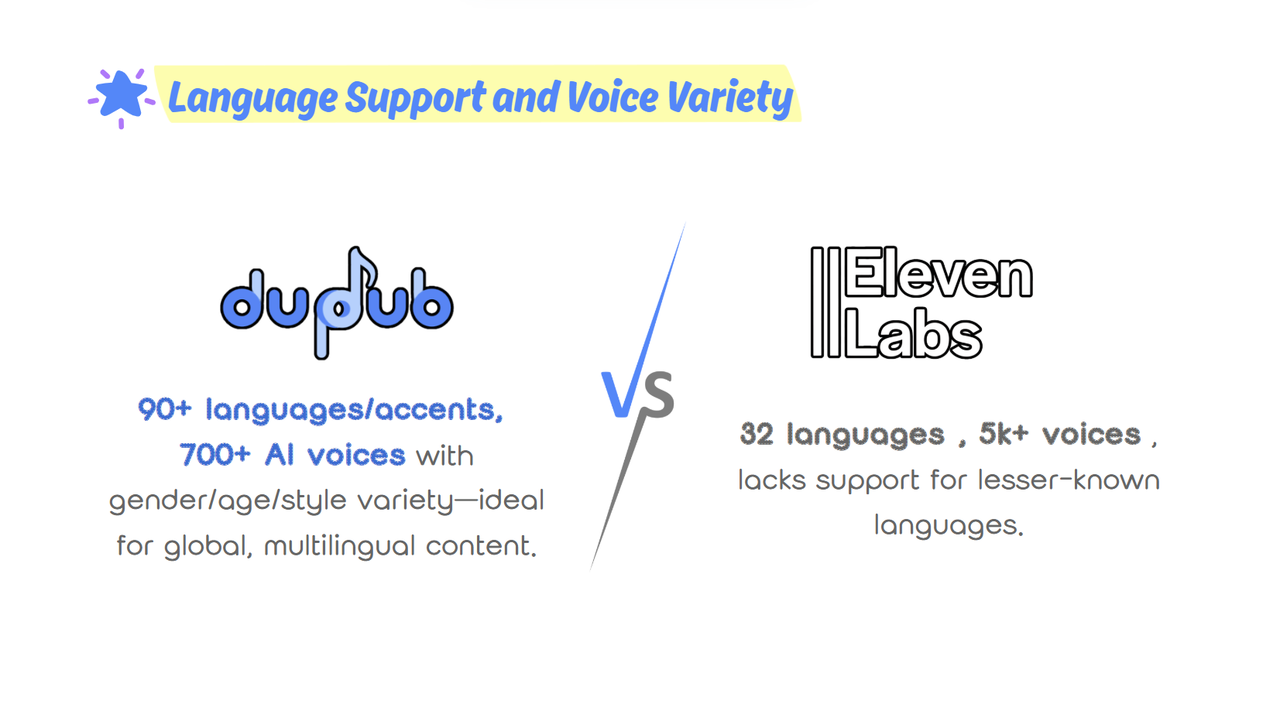
One of the biggest differences is the range of languages and voices each supports. DupDub is built for a global audience – it supports over 90 languages and accents. This includes not only all major languages (English, Chinese, Spanish, Arabic, Hindi, French, etc.) but also many regional languages and dialects. In total, DupDub offers a library of 700+ AI voices, so users can find voices of different genders, ages, and styles across dozens of languages. For instance, you can get a Brazilian Portuguese male voice for a documentary, a youthful Japanese female voice for an anime video, or a neutral American English narrator – all within the same platform. This breadth is ideal for creators who localize content or produce multimedia in multiple markets. You’re likely to find a fitting voice in the target language without much compromise.
ElevenLabs, in contrast, supports 32 languages as of 2025. Its initial focus was English (and it still offers the most variety in English voices), but it has since expanded into other major languages like Spanish, French, German, Japanese, Chinese, Hindi, and more. The platform includes a voice library of over 5,000 voices, though many of these are user-generated community voices, which can vary in quality and expressive consistency.
For instance, while ElevenLabs may offer reliable coverage for languages like German or French, it lacks support for several key markets. In contrast, DupDub provides voices in additional languages such as Swahili, Urdu, Mongolian, Welsh, and Javanese, expanding reach and relevance for international content producers.
In short, DupDub offers significantly broader language support and greater stylistic flexibility. If your project requires multiple languages or varied emotional tones, DupDub is more likely to provide the right voice at the right level of expressiveness. ElevenLabs delivers exceptional quality in a narrower language set—especially in English—but for creators producing across cultures, DupDub’s expansive voice catalog feels less like a list of options and more like a multilingual cast.
Voice Cloning and Custom Voices
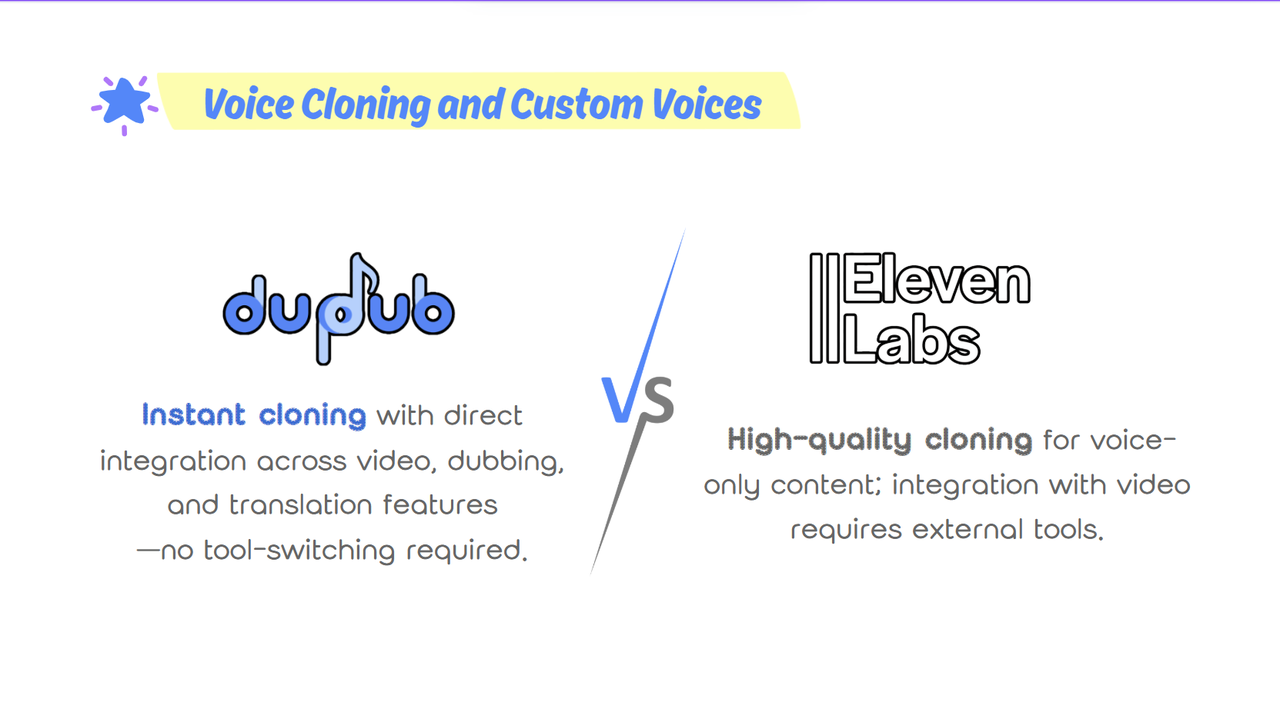
Both DupDub and ElevenLabs offer voice cloning capabilities, allowing users to replicate their own voice with a short audio sample. The cloning process is relatively fast and easy on both platforms.
Where DupDub stands out is in how seamlessly the cloned voice integrates across the creative workflow. Once a voice is cloned, it can be used immediately for dubbing, translation, avatar animation, and full video generation—all within the same platform. There’s no need to export the voice, upload it elsewhere, or manually sync it to visuals. For creators producing localized video content or building automation pipelines, this integration significantly reduces production friction.
ElevenLabs, while offering high-quality voice cloning, focuses on audio generation. Its cloned voices are primarily used for narration or character voiceovers and are not directly integrated into a visual or video workflow. Users needing to apply those voices in a video context would typically need to use third-party tools.
Summary:
-
DupDub: Instant cloning with direct integration across video, dubbing, and translation features—no tool-switching required.
-
ElevenLabs: High-quality cloning for voice-only content; integration with video requires external tools.
AI Video and Dubbing Features

Beyond just audio, DupDub and ElevenLabs diverge significantly in video-related features and other AI tools. DupDub positions itself as an all-in-one media platform, not just a voice generator. It offers unique video capabilities integrated with its voice tech:
-
Talking AI Avatars: DupDub allows you to create an AI video presenter from a single image. You can upload a photo (or choose a stock avatar) and then generate a video where that avatar speaks your script. The avatar’s lip movements are synced to the spoken audio. This essentially gives you a “talking head” video automatically. It’s useful for creating spokesperson videos, educational content with a virtual narrator, or adding a face to voiceovers without filming a real person.
-
Automated Video Dubbing with Lip-Sync: If you have an existing video and need it in another language, DupDub can help via its video dubbing feature. You input the original video and script, translate the script (DupDub can also assist with AI translation), and then generate a new voice track in the target language. DupDub will synchronize the new voice to the speaker’s lip movements in the video. The result is a dubbed video where the on-screen speaker’s mouth matches the new audio – a huge time-saver for localization. For example, you could dub an English marketing video into French and it will look relatively natural, as if the person spoke French on camera.
-
Subtitles and Transcription: DupDub includes speech-to-text tools that can transcribe audio or video into text, and generate subtitles. This ties in with dubbing – you can transcribe the original, translate, then synthesize the new speech, all in one platform. It also means creators can easily produce captions for accessibility.
-
Background Audio and Editing: DupDub provides some built-in extras like adding background music or sound effects to your generated voiceover, adjusting speech speed and pitch, and even a script assistant to refine your text before converting to speech. This makes it a mini production studio.
ElevenLabs, by contrast, is more singularly focused on audio. It does not offer avatar video creation or automatic lip-sync video dubbing in its standard toolkit. The platform’s feature set revolves around voice generation and related audio processing:
-
ElevenLabs has an “AI Dubbing” capability, but it’s primarily the audio dubbing (voice translation) aspect. For example, ElevenLabs can take text in one language and generate a spoken version in another language with a similar voice. However, it doesn’t itself handle the video lip synchronization – you would get the dubbed audio and need to align it to the video manually or with another tool.
-
There are no animated avatars or video rendering features in ElevenLabs. It’s expected that users will use third-party video editors or specialized tools to integrate the audio into videos.
-
ElevenLabs does offer some novel audio tools like a Voice Changer (to morph one voice into another style), Voice Isolator (to remove background or isolate voice, likely for cleaning up audio inputs), and Sound Effects (perhaps for adding effects to voices). These are more auxiliary features aimed at audio customization and are included in their platform for advanced users. For example, a creator might use voice changer to alter a recorded voice or the isolator to prep a clip for cloning.
In summary, DupDub provides a richer feature set for video creators. If your workflow involves video content and you’d like the AI to handle as much as possible (from voiceover to on-screen avatars and synced dubbing), DupDub is a clear winner. It essentially covers both voice and video production needs in one place. ElevenLabs sticks to being an audio specialist – it gives you extremely high-quality voices and some audio editing tools, but you’ll handle the video aspect elsewhere. For someone who only needs voiceovers to plug into videos manually, ElevenLabs is perfectly fine. But for those looking to automate video voice replacement or create AI-driven video content, DupDub’s integrated video capabilities are a huge advantage.
Usability and User Experience

A tool can have great features, but it also needs to be user-friendly. Let’s compare how easy DupDub and ElevenLabs are to use and navigate.
ElevenLabs offers a very simple, streamlined user experience. It provides an online studio interface where you can type or paste text, choose a voice, and generate speech with a click. The design is minimalist – geared towards letting you produce audio quickly. You can adjust a few settings (voice stability, clarity, etc.) via sliders to tweak the output, but the interface doesn’t overwhelm you with options. If you want to clone a voice, the VoiceLab guides you to upload samples and manage your custom voices in a straightforward way. ElevenLabs also heavily supports API usage: many users integrate ElevenLabs into their own apps or workflows, which means the service is designed to work smoothly for developers (with clear documentation and a focus on quick generation). Overall, ElevenLabs is beginner-friendly for basic text-to-speech tasks and equally appreciated by tech-savvy users for its efficiency. Since it focuses on voices, the learning curve is mild – you can get results in minutes without reading long guides.
DupDub has a modern and well-organized interface, but it naturally feels more complex only because it offers more features in one place. When you log into DupDub’s web studio, you’ll see a dashboard with multiple modules: AI Voiceover, Video Dubbing, Voice Cloning, Subtitle, etc. For a new user, there’s a lot you can do, although you don’t have to use everything. The core text-to-speech function in DupDub is straightforward: enter text, select language and voice from dropdowns (with previews), and generate. The interface for that is clean, with options to change speed, pitch, add pauses or emphasis tags, etc. As you explore, you might click into the video avatar section, which then introduces the workflow for making an avatar video. DupDub often provides step-by-step workflows or wizards for complex tasks (for example, the video translation module might guide you: 1) upload video, 2) transcribe/translate, 3) choose voices, 4) export video). This guidance helps, but it’s true that DupDub has more to learn overall. A user purely looking to do a quick voiceover might initially be a bit overwhelmed by all the extra capabilities on the platform.
In terms of workflow efficiency:
-
If your needs are simple (one language voiceover, short clips), ElevenLabs’ focused interface might get you from text to audio slightly faster, due to fewer clicks and choices.
-
DupDub, however, can save a lot of time when doing complex projects. The reason is you don’t have to jump between multiple tools. For example, suppose you want to create a Spanish dubbed version of an English video. In DupDub, you can do it all: transcribe English, translate to Spanish, generate Spanish voiceover, and produce the dubbed video with subtitles. In a conventional workflow, you might need separate software for transcription, separate for translation, separate for TTS, then a video editor for dubbing. So, for multi-step multimedia tasks, DupDub’s all-in-one approach is very efficient. You set up everything in one platform, which can be a huge time saver once you learn it.
For beginners or non-technical users: ElevenLabs is extremely plug-and-play for voice generation. DupDub is also designed for general users (no coding or special skills needed), but it may require a bit more exploration. After an hour of usage, most people get comfortable with whichever tool they choose. DupDub has tutorials and guides given its broader scope, whereas ElevenLabs doesn’t need much instruction beyond a quick tour.
In terms of platform stability and performance: both are cloud-based and generally fast. ElevenLabs prides itself on quick generation (including a low-latency mode on higher plans), so you get results in seconds for most tasks. DupDub also processes voiceovers quickly, though heavy tasks like rendering a full video or doing long transcripts will naturally take longer than just generating audio. Both have autosave or project features – ElevenLabs allows saving projects (especially with its new Studio for long-form content), and DupDub lets you save your work, manage files, and so on.
Summary: ElevenLabs is a smooth, focused experience strictly for voice tasks – extremely easy to learn and use. DupDub offers a broader suite, which means a bit more complexity, but it pays off if you plan to utilize those additional tools. If you only ever need basic TTS, you might prefer the simplicity of ElevenLabs. If you foresee needing translation, cloning, or video features, investing time to learn DupDub will give you a powerful one-stop creation studio.
Integrations and Output Formats
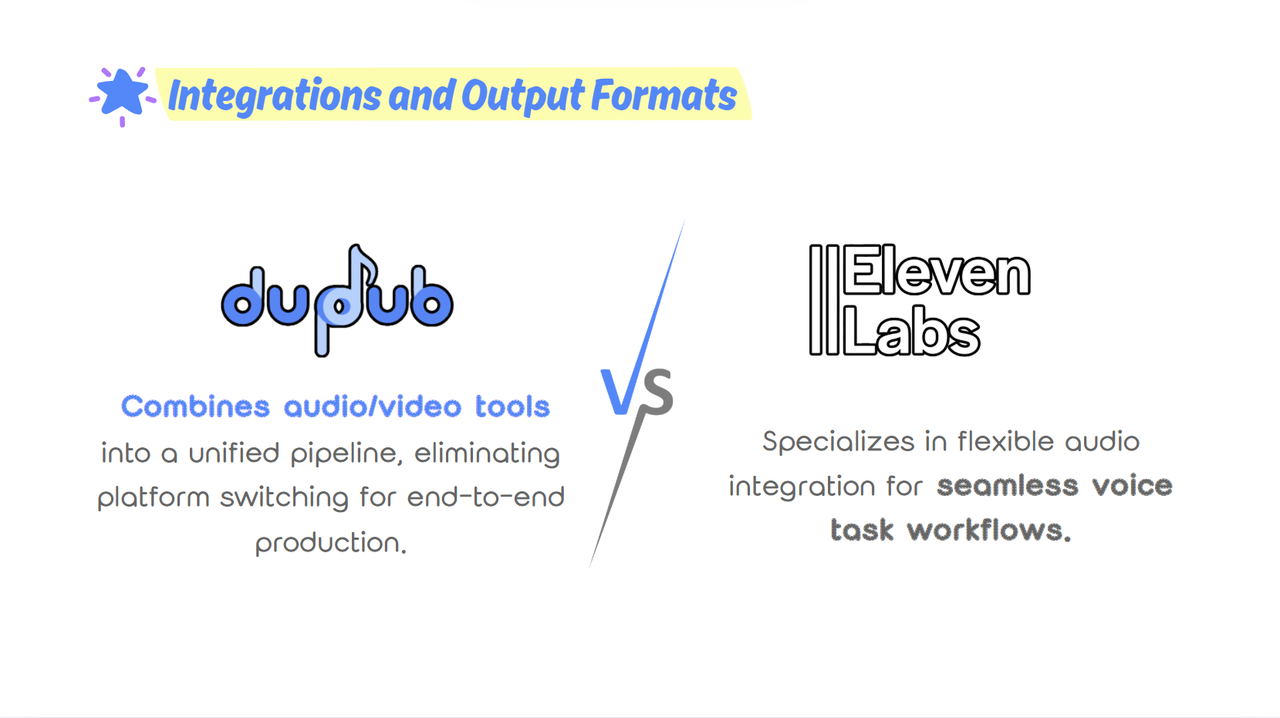
Both platforms offer API access for developers, allowing easy integration into custom apps or workflows.
ElevenLabs is widely adopted in the developer community and integrates well into third-party tools. However, it doesn’t provide direct plugins for content creation platforms.
DupDub supports API and also offers plug-and-play integrations—such as with Canva and ChatGPT—making it more accessible for non-technical users.
In terms of output, both support MP3 and WAV downloads. ElevenLabs focuses strictly on audio export, while DupDub also enables video exports, including dubbed videos and talking avatar presentations.
Summary: ElevenLabs excels in flexible audio integration. DupDub supports both audio and video workflows, offering creators a complete production pipeline without switching platforms.
Pros and Cons Summary
DupDub – Pros
Supports 90+ languages and accents—ideal for global content localization.
700+ voices with 1000+ styles, including expressive tones for storytelling.
Voice cloning and video avatars included even in entry plan.
Built-in tools for video dubbing, subtitle generation, and translation.
Unified credit system covers voice, video, and translation—flexible for creators.
Higher cost-efficiency at mid- and high-tier usage (more output per dollar vs. ElevenLabs).
DupDub – Cons
Credit system requires understanding how different features consume credits.
Slight learning curve due to broad feature set.
No permanent free plan—only a 3-day trial.
ElevenLabs – Pros
Exceptional realism, especially for English voiceovers.
Minimal interface, fast generation—ideal for quick TTS use.
Strong developer adoption and well-documented API.
Offers a low-cost entry tier ($5/mo) for light usage.
ElevenLabs – Cons
Only 30+ languages, with limited voice variety beyond English.
No built-in video tools, avatars, or subtitle support.
Higher price per hour of output at scale compared to DupDub.
Free plan is non-commercial and limited in minutes.
Conclusion
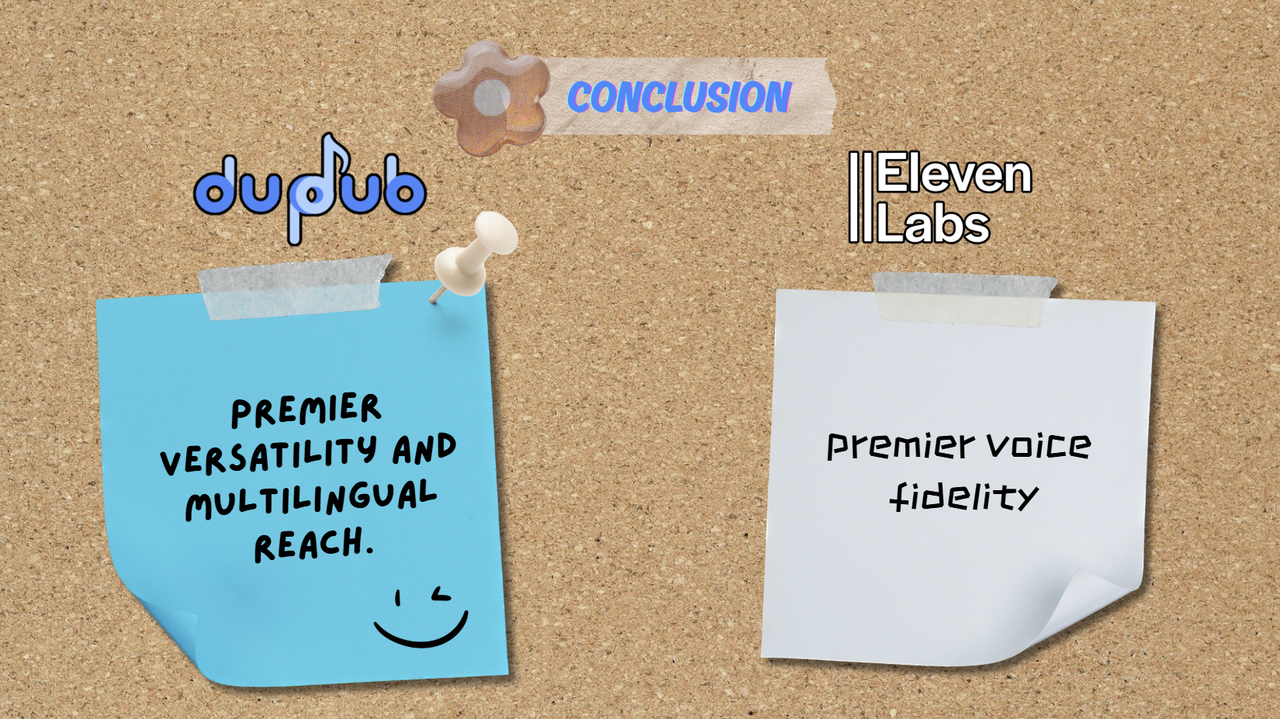
Both DupDub and ElevenLabs are top-tier AI voice generators in 2025, but they cater to slightly different needs. ElevenLabs has made a name for itself with ultra-realistic voices and emotional depth, predominantly in English. It’s the go-to for those who want their AI voices to sound as human as possible with minimal tweaking. Think of ElevenLabs as a specialist: it does one thing exceedingly well – generate speech that could fool you into thinking a human said it.
DupDub, on the other hand, is like a creative powerhouse suite. It may not always match the last 1% of realism that ElevenLabs’ best English voice achieves, but it delivers very high-quality voices across an unparalleled range of languages and use-cases. DupDub is the choice for content creators and businesses who need a comprehensive solution: not just voice, but voice + translation + video, all integrated. It empowers you to do things that would normally require a small team of editors and multiple software tools – all within one platform.
In 2025, if we ask “which AI voice generator wins?”, the answer truly depends on what winning means for you:
-
If winning means sounding the most human in English narration or dialogue, ElevenLabs likely wins for you.
-
If winning means reaching the most people across languages, automating your workflow, and creating entire multimedia experiences powered by AI, DupDub wins in that arena.
From a future perspective, DupDub is rapidly improving its voice quality (particularly in English) and expanding its features, which means the gap in raw voice realism is closing. Meanwhile, ElevenLabs is also adding more languages and features gradually. It’s conceivable that in the near future, each will encroach on the other’s territory (ElevenLabs adding more language breadth, DupDub achieving even more realism). But as of 2025, the distinction remains: ElevenLabs = premier voice fidelity; DupDub = premier versatility and multilingual reach.
Ultimately, many content creators might find that DupDub gives them more long-term value – especially if they want to scale up production and engage global audiences. DupDub’s all-in-one nature is forward-thinking as media creation becomes increasingly automated and international. ElevenLabs remains a reliable, superb choice for high-quality voice needs and will continue to be the benchmark for natural AI speech in its supported languages.
Our advice: assess your projects and audience. You can even try both (ElevenLabs’ free plan and DupDub’s trial) to see which interface and output you prefer. There’s no one-size-fits-all winner, but there is a best choice for you. The good news is that whether you choose DupDub or ElevenLabs, you’ll be harnessing cutting-edge AI that can save time, reduce costs, and open up new creative possibilities in voice content. Both tools represent how far voice AI has come – enabling anyone to have a realistic narrator or a multilingual voice actor on demand.

